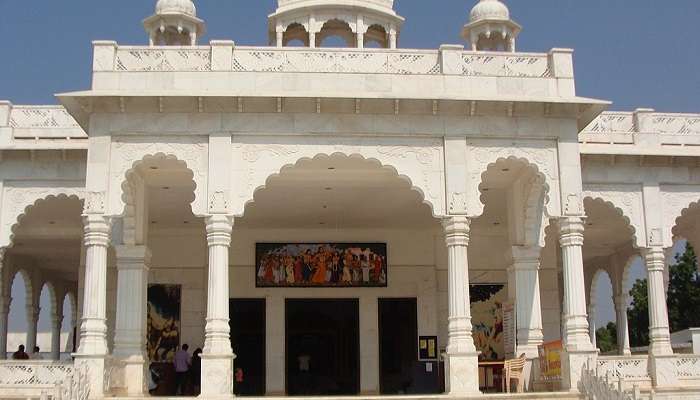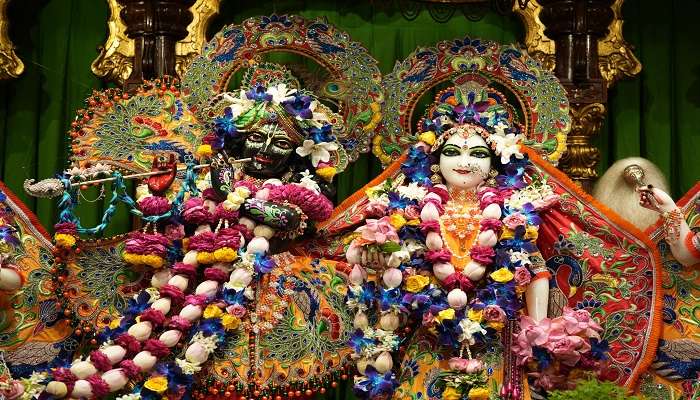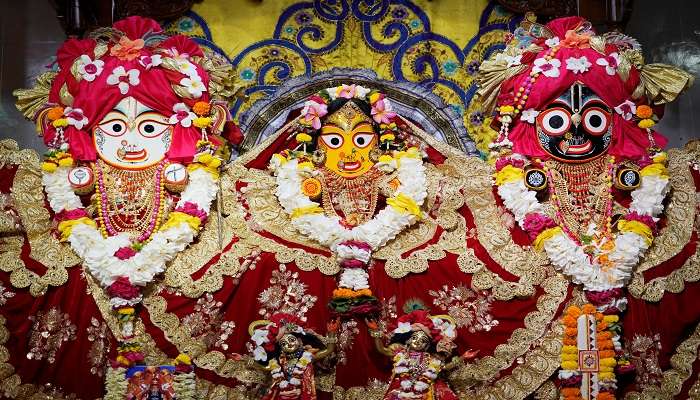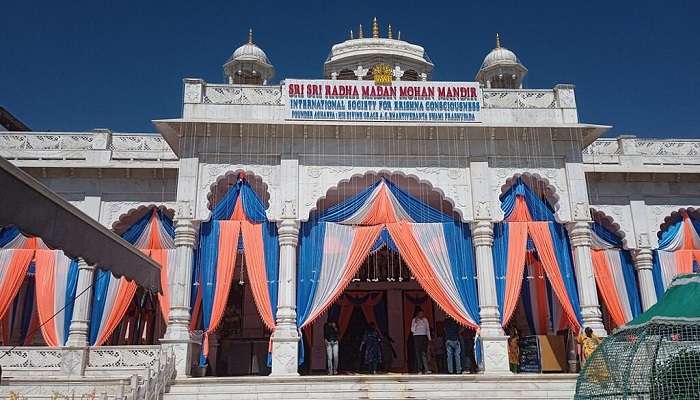Discovering The Unending Serenity Of ISKCON Ujjain Temple In 2026

Have you ever been captivated by the sight of a magnificent temple, the aura of the idol, the intricate carvings on walls, and the air filled with the melodic chanting of the mantras and the fragrance of incense sticks?These could be the temples belonging to the International Society for Krishna Consciousness, also known as ISKCON. Well, Iskcon Ujjain temple was founded in 1966 by Bhaktivedanta Swami Prabhupada. Additionally, ISKCON is a worldwide spiritual organisation that is mainly dedicated to Lord Krishna, a central figure in Hinduism. Moreover, ISKCON temples are also a centre of education, as they provide workshops, lectures, and education, based on the Hindu scriptures, such as Srimad Bhagavatam and Bhagavad Gita.
Design And Structure Of The Iskcon Ujjain Temple

The ISKCON Ujjain temple, also known as the Sri Sri Radha Madan Mohan temple, stands out for its traditional Hindu aesthetics and beautiful blend of modern architecture. Let’s discuss about the design and structure of the temple in detail below:
A Marble Marvel: This temple’s most striking feature is its use of pristine white Makrana marble, the same exquisite material that adorns the Taj Mahal. These marbles give the temple a sense of grandeur and purity, reflecting divinity.
Traditional Touches: Although the overall structure of the ISKCON temple lends itself to modern design, it incorporates some conventional elements that resonate best with the architecture of the Hindu temple. Moreover, the intricate carvings and vibrant paintings adorning the pillars and walls depict scenes from Lord Krishna’s life, adding to a touch of cultural richness.
Also Read: Places To Visit In Ujjain
Main Deities Worshipped At ISKCON Ujjain Temple

The ISKCON Ujjain temple, also known as the Sri Sri Radha Madan Mohan temple, pulsates with the devotional worship of a central couple. Let’s know about the main deities being worshipped here:
Goddess Radha: Goddess Radha embodies divine love and selfless devotion towards Lord Krishna. However, Radha is not considered an incarnation of a goddess but instead personifies the ideal devotee’s pure love for the divine. Radha’s love for Krishna is unconditional and selfless, and hence, it inspires devotees on the path of bhakti yoga.
Shri Madan Mohan: Madan Mohan, which translates to “enchanting Mohini,” signifies Krishna’s captivating nature. His playful nature and charming demeanour are said to steal the hearts of all who encounter him.
Lord Rama: Lord Rama, an incarnation of Lord Vishnu, is known to be an ideal king and embodiment of righteousness. Moreover, his presence in the temple is depicted in a murti depicting him with his consort Sita, his brother Lakshmana, and the monkey god Hanuman.
Lord Narasimha: Lord Narasimha is the fierce form of Lord Vishnu with a lion’s head. He embodies Vishnu’s power to protect his devotees from harmful energies. His murti in the temple complex depicts an assertive posture, symbolising his ferocity and unwavering protection.
Lord Ganesha: The elephant-headed deity Lord Ganesha is known to remove obstacles and bestow auspicious beginnings. The murti of Lord Ganesha at the temple entrance is a common feature that ensures a successful and smooth pilgrimage for the devotees.
Daily Rituals And Puja At ISKCON Ujjain Temple

The ISKCON temple, Ujjain, like any other ISKCON temple worldwide, follows a structured daily routine filled with holy pujas. Here’s a glimpse into what a typical day at ISKCON entails:
Mangala aarti (Early morning offering): The day at ISKCON begins with Mangala aarti, an early morning ceremony. In this ceremony, the deities are awakened and offered prayers, hymns, chants and lamps filled with ghee. This sets the perfect tone to begin a devotional day.
Shringar aarti (Morning dressing): As the day progresses, there’s another aarti known as Shringaar aarti, which is performed to dress up the lord. This beatification ceremony involves adorning the deities with fresh flowers and fragrant garlands. This ceremony symbolises divine grace and beauty.
Krishna Katha: Well, some sessions are going on in the temple dedicated to Lord Krishna, and hence, this goes on throughout the day. These sessions include chanting and reciting scriptures such as Srimad Bhagavatam and Bhagavad Gita. Moreover, in these sessions, devotees are allowed to delve deeper and understand the teachings of Lord Krishna and his philosophy.
Midday Offering: There’s a midday aarti followed by prasadam offerings. This likely takes place during the daytime and in the afternoon; hence, the devotees are expected to take prasadam after it is offered to the deities.
Gita Discourse: In the afternoon, the temple organises a lecture-based discourse on the Bhagavad Gita, a key scripture in Hinduism. These interactive sessions provide devotees with the opportunity to gain knowledge and insights into the methodology and ask questions.
Sandhya aarti: As the evening approaches, there’s another aarti in the temple, also known as Sandhya aarti, which is performed at the end of the day. During this aarti, some prayers and offerings are made to the deities; then they are prepared for their celestial rest.
Shayan aarti: Finally, before the temple closes, Shayan aarti is performed. This lullaby-like aarti is to bid goodnight to the deities and ensure their peaceful slumber.
Related Post: Temples In Ujjain
Spiritual Activities In The Temple

Beyond the daily rituals and pujas, some spiritual activities are conducted in the temple as it fosters a positive and vibrant environment. Let’s explore what they are:
Bhajans: Bhajans are devotional songs sung by devotees and accompanied by instruments such as karats and harmoniums. They create a soulful atmosphere, allowing the devotees to express their love and devotion to the lord through music.
Kirtans: Kirtans are similar to bhajans, but they are call-and-response chants that often involve chanting the holy names of Krishna, like “Hare Krishna” or “Hare Rana.” These chants are highly energetic and create a sense of spiritual ecstasy.
Lectures: The temple holds lectures based on the Bhagavad Gita, Srimad Bhagavatam, and other Hindu scriptures. These lectures are conducted by knowledgeable devotees or visiting speakers.
Meditation: The ISKCON Ujjain temple also regularly conducts guided meditation sessions. These sessions allow devotees to attain quiet peace of mind while connecting with their inner selves.
Special Events And Festivals Conducted In The ISKCON Ujjain temple

The ISKCON temple celebrates a vibrant calendar of annual special events and festivals. Here’s a glimpse at the most significant ones:
Janmashtami: Janmashtami is undoubtedly among the crown jewels of the ISKCON festivals, as this festival marks the birth of Lord Krishna. The temple complex comes alive with elaborate decorations and devotional kirtans. The festival’s highlight is Krishna’s birth scene and the midnight Abhishek.
Rath Yatra: Rath Yatra is a colourful and super-exuberant festival commemorating Krishna’s majestic journey from Mathura to Vrindavan. Moreover, the ISKCON temple constructs a towering chariot, usually adorned with vibrant colours and intricate carvings, upon which the deities of Krishna, Balarama, and Subhadra are placed. In Rath Yatra, devotees joyously pull the chariot through the streets, singing and chanting kirtans.
Guru Purnima: Guru Purnima is a festival that marks the day of Chaitanya Mahaprabhu, a revered saint and vital figure in the Vaishnava tradition. Special pujas are dedicated to Chaitanya Mahaprabhu, celebrating his life and teachings.
Related Post: Mahakaleshwar Temple Ujjain
Practical Tips To Keep In Mind
- It’s necessary to remove your shoes outside the temple complex before entering.
- Do not talk in loud noise, and maintain decorum within the temple complex.
- Moreover, photography may be restricted in some parts of the temple.
- Hence, it’s crucial to get permission before capturing.
- Moreover, if you wish to make an offering, you can do that in the form of flowers, sweets and even money.
You May Also Like To Read: Picnic Spots Near Ujjain
Whether you’re a seasoned devotee or a curious traveller willing to learn about Krishna consciousness, the ISKCON Ujjain temple welcomes you with open arms. However, some basic principles must be followed to ensure respect. So, pack your bags, book a trip to Ujjain, and allow yourself to be touched by the beauty and devotion that radiate from the ISKCON temple.
For our editorial codes of conduct and copyright disclaimer, please click here.
Cover Image Credit : Gyanendrasinghchauha for Wikimedia Commons
Frequently Asked Questions About ISKCON Ujjain Temple
What is the history of the ISKCON Ujjain Temple?
The exact founding date remains a mystery, but the temple likely postdates 1966, the establishment year of ISKCON. Its location in Ujjain, a holy city, hints at a rich history potentially intertwined with the area's spiritual significance.
Who are the main deities worshipped at the temple?
The central deities are Sri Sri Radha Madan Mohan, symbolising divine love. Other deities like Lord Rama and Lord Ganesha might also be enshrined, catering to a wider range of devotees.
What can I expect during a visit to the temple?
Expect a serene atmosphere filled with devotional chanting and beautiful murtis (idols). Daily rituals and pujas offer structure, while activities like bhajans and kirtans encourage participation. The temple welcomes visitors with open arms, regardless of their background.
Are there any festivals celebrated at the temple?
Absolutely! The temple comes alive during festivals like Janmashtami (Krishna's birthday) and Rath Yatra (chariot festival), offering a chance to immerse yourself in the joy of Krishna Consciousness.
What should I wear when visiting the temple?
While there's no strict dress code, modest clothing that covers shoulders and knees is recommended as a sign of respect.
People Also Read:
Manu Temple Shri Amarnath Cave Temple Yamunotri Temple

Unveil the hidden treasures of the globe and turn every travel dream into reality. As a Content Writer, I am passionate enough to craft stories from ancient wonders to modern marvels. My words paint the picture-perfect itinerary for unforgettable experiences. Let my words be your trusted guide to immerse in the diverse culture and discover the beauty of the unknown.











